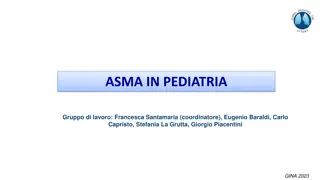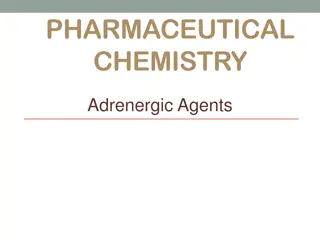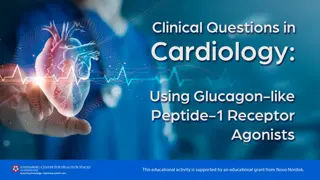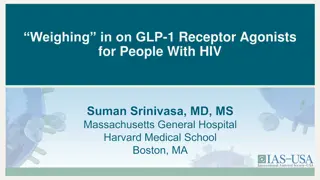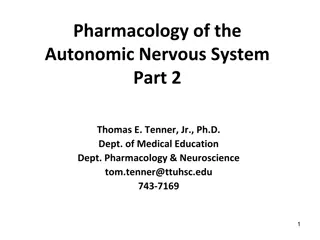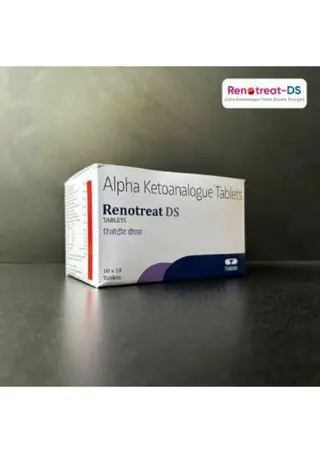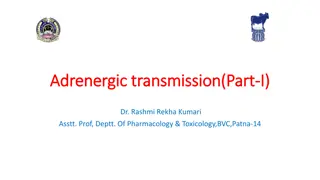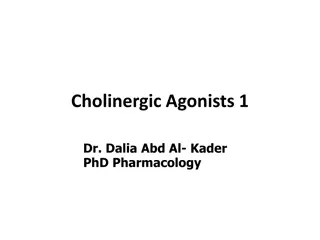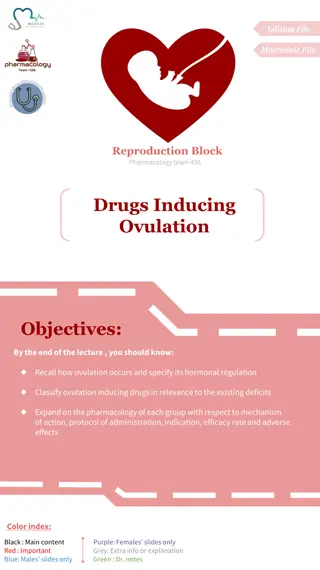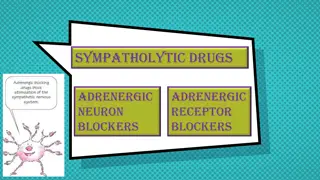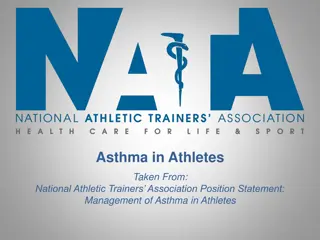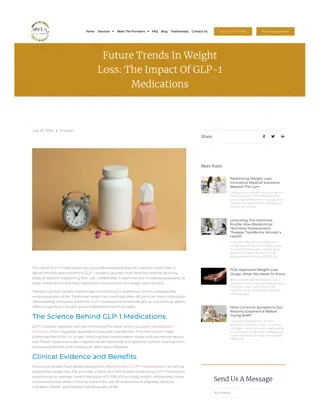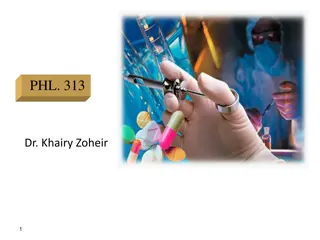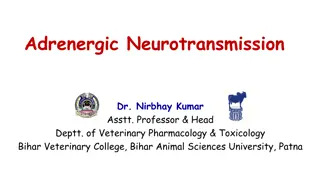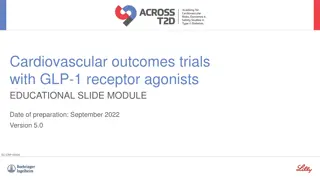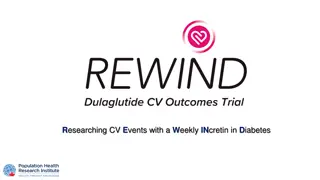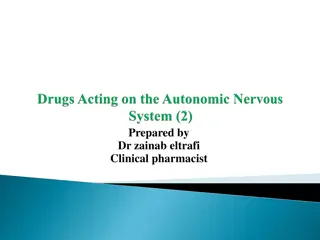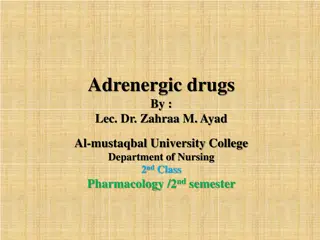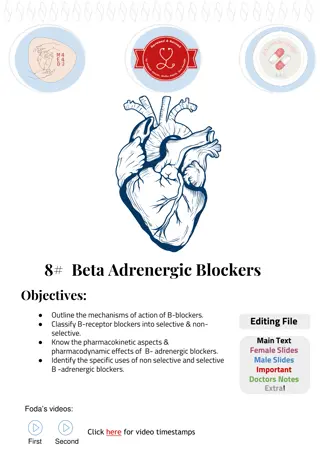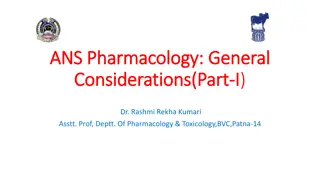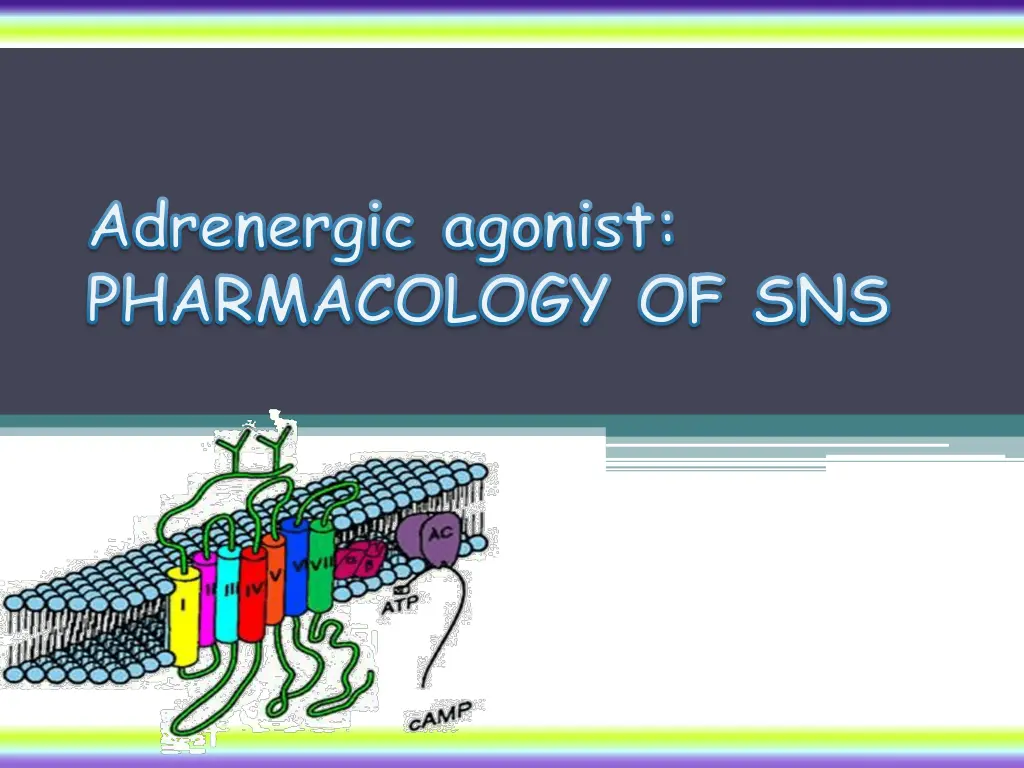
Understanding Adrenergic Agonists and Stimulants in Pharmacology
Explore the pharmacology of adrenergic agonists and stimulants related to the sympathetic nervous system. Learn about different types of adrenergic stimulants, their modes of action, and indications for adrenaline usage. Dive into the world of direct, indirect, and dual sympathomimetics to enhance your understanding of this vital pharmacological category.
Download Presentation

Please find below an Image/Link to download the presentation.
The content on the website is provided AS IS for your information and personal use only. It may not be sold, licensed, or shared on other websites without obtaining consent from the author. If you encounter any issues during the download, it is possible that the publisher has removed the file from their server.
You are allowed to download the files provided on this website for personal or commercial use, subject to the condition that they are used lawfully. All files are the property of their respective owners.
The content on the website is provided AS IS for your information and personal use only. It may not be sold, licensed, or shared on other websites without obtaining consent from the author.
E N D
Presentation Transcript
Adrenergic agonist: PHARMACOLOGY OF SNS
ADRENERGICS STIMULANTS [AGONISTS] Direct Sympathomimetics Indirect Sympathomimetics Dual Sympathomimetics
ADRENERGIC STIMULANTS According to chemistry; Catecholamines; Rapidly acting / Degraded by MOA & COMT Sparse CNS effects / Parenterally administered Non-Catecholamines; Ephedrine Delayed action / Resist degradation by MOA Prominant CNS effects / Orally administered Natural; NE, E, Dopamine Synthetic; Isoprenaline According to spectrum of action; Non-Selective; Norepinephrine, epinephrine, dopamine, isoprenaline, ephedrine, etc Selective; 1; Phenylephrine 2; Clonidine 1; Dobutamine 2; Salbutamol
ADRENERGIC STIMULANTS According to mode of action; Direct; Stimulate adrenergic receptors directly. e.g. adrenaline, noraderanaline, dopamine, isoprenaline, phenylephrine, methoxamine, naphazoline, clonidine, dobutamine, salbutamol .etc Indirect; Release of NE from presynaptic stores at adrenergic nerve terminals e.g. amphetamine Or Inhibit uptake its availability in synapse. e.g. Cocaine & antidepressants Dual; Direct and indirect stimulation of adrenergic receptors e.g. ephedrine, pseudoephedrine
ADRENERGICS AGONISTS Direct Sympathomimetics
DIRECT Acting Sympathomimetics ADRENERGIC STIMULANTS ADRENALINE ADRENALINE Naturally released from adrenal medulla 2ndry to stress, hunger, fear Inactivated by intestinal enzymes, so given parentral & by inhalation Acts on all ADR; =/> Pharmacological actions Heart inotropic, chronotropic, dromotropic ( excitability)( ) ) BP systolic ( ) ) / diastolic low dose ( ) ) & high dose ( ) ) Vascular SMC; constrict skin + peripheral ( ) ) dilate coronary+skeletal ( ) ) Non vascular SMC; Lung bronchiodilatation ( ) ) Pregnant uterus tocolytic ( ) ) Eye mydriasis ( ) ) / no effect on accommodation or intraocular P CNS little, headache, tremors & restlessness
ADRENALINE ADRENALINE Indications Used locally; as haemostatic (in epistaxsis) & as decongestant ( ) ) with local anesthetics to + Used systemically for treatment of Allergic reactions drug of choice in anaphylactic shock as it is the physiological antagonist of histamine BP & cause vasoconstricton In status asthmatics given parentally bronchodilatation ( 2) + mucosal edema ( 1) N.B. Selective 2 are better in asthma by inhalation In cardiac arrest direct but now through central line N.B. Selective 1 are better its absorption & toxicity bleeding from incision
ADRENALINE ADRENALINE ADRs Tachycardia, palpitation, arrhythmias, angina pains Headache, weakness, tremors anxiety and restlessness. Hypertension cerebral hemorrhage and pulmonary edema. Coldness of extremities tissue necrosis and gangrene if extravasation Nasal stuffiness; rebound congestion if used as decongestion Contraindications CHD, hypertension, peripheral arterial disease. Hyperthyroidism. Closed-angle glaucoma (ciliary relaxation filtration angle IOP
ADRENERGIC STIMULANTS Direct Acting Sympathomimetics NOREPINEPHRINE = NORADRENALINE NOREPINEPHRINE = NORADRENALINE It is naturally released from postganglionic adrenergic fibres Not used much therapeutically severe vasoconstriction Acts on > 1 Only administered IV - Not IM or Subcutaneous necrosis It BP [ systolic & diastolic] reflex bradycardia (vagal stimulation) CO not much changed Indications Used systemically; hypotensive states (inspinal anesthesia, in septic shock if fluid replacement and inotropics fail) !!! Used topically; as a local haemostatic with local anesthetic (< tachycardia & irritability & > necrosis & sloughing)
ADRENERGIC STIMULANTS Direct Acting Sympathomimetics ISOPRENALINE ISOPRENALINE It is synthetic ; show no presynaptic uptake nor breakdown by MOA longer action. Acts on >> 10 times > broncho-dilatation Was used by inhalation in acute asthma Used in cardiac arrest but contraindicated in hyperthyroidism & CHD Heart 1 force Kidney D1 vasodilatation + diuresis DOPAMINE It is a natural CNS transmitter. Released from postganglionic adrenergic fibres (> renal vessels) Releases NE from postganglionic adrenergic fibres Acts on D1 > 1 > 1 Vessels 1
ADRENERGIC STIMULANTS Direct Acting Sympathomimetics DOPAMINE On heart Inotropic, no chronotropic effect On BP According to dose; first D1 then due to 1 followed by 1 effect Given parentrally by infusion Indications It is the drug of choice in treatment of SHOCK septic, hypovolaemic (after fluid replacement), cardiogenic It BP & CO ( ), without causing renal impairment (D1) Can be given in acute heart failure (HF) but better dobutamine
ADRENERGIC STIMULANTS Direct Acting Sympathomimetics DOBUTAMINE It is synthetic. Given IV. Acts on 1 > 2 > 1 On heart Inotropic with little chronotropic effect On BP No or little in therapeutic dose ( 1 & 2 counterbalance + no 1 ) Indications Given parentrally by infusion for short term management of cardiac decompensation after cardiac surgery, in acute myocardial infarction (AMI) & HF. It is preferred because it does not oxygen demand
ADRENERGIC STIMULANTS Direct Acting Sympathomimetics PHENYLPHERINE It is synthetic, noncatecholamine. Given orally & has prolonged duration of action. Acts as selective 1 MIDODRINE Peaks in 20 min. t 30 min. On heart reflex bradycardia On BP due to vasoconstriction ( 1 ) In Hypotension Indications Systemically; Pressor agent in hypotensive states. Infusion Terminate atrial tachycardia(reflex bradycardia) Nasal decongestant. Oral Topically; Local Haemostatic, with Local anesthesia. Decongestant (nasal & ocular) Mydriatic (no cycloplegia so facilitate eye examination)
ADRENERGIC STIMULANTS Direct Acting Sympathomimetics Nasal & Ocular Decongestants PHENYLETHYLAMINES Phenylephrine Methoxamine IMIDAZOLINE Naphazoline Oxymetazoline HCI (Afrin) Xylometazoline HCI (Otrivine) Pseudoephedrine Used for treatment of nasal stuffiness But can cause Rebound nasal stuffiness It is synthetic, imidazoline Given orally or as patch. Acts selectively on presynaptic 2 BP by action on ( 2 ) at nucleus tractus solitarius to heart & vessels. Antihypertensive agent N.B.Brimonidine is an imidazoline 2 agonist used in glucoma CLONIDINE sympathetic outflow to
ADRENERGIC STIMULANTS Direct Acting Sympathomimetics SALBUTAMOL It is synthetic. Given orally, by inhalation or parentral. Acts selectively on 2 on bronchi. Hardly effect on heart ( ) Bronchodilater asthma & chronic obstructive airway disease (COPD) N.B.Because t1/2 is 4 hrs longer acting preparations exist ; Salmeterol & Formoterol Other selective 2 agonists : Terbutaline Terbutaline; ; Bronchodilator & Tocolytic Ritodrine Ritodrine; ; Tocolytic postpone premature labour (labour that begins before the 37th week of gestation).
ADRENERGICS STIMULANTS [AGONISTS] Indirect Sympathomimetics
ADRENERGIC STIMULANTS INDIRECT Acting Sympathomimetics AMPHETAMINE It acts indirectly; Releasing NE from adrenergic nerve endings > Blocking of its reuptake Because it depletes vesicles from stored NE tachyphylaxsis Absorbed orally, not destroyed by MAO, excreted mostly unchanged ( by acidification of urine) Acts on & similar to epinephrine but has CNS stimulant effects; mental alertness, wakefulness, concentration & self-confidence / followed by depression & fatigue on continued use euphoria causes its abuse .. Weight increase energy expenditure appetite No more used therapeutically induces psychic & physical dependence and psychosis + the CVS side effects
ADRENERGICS STIMULANTS [AGONISTS] Dual Sympathomimetics
ADRENERGIC STIMULANTS DUAL Acting Sympathomimetics EPHEDRINE Plant alkaloid, synthetic, mixed sympathomimetic; Prolonged direct action on receptors receptor down regulation Release NE from adrenergic nerve endings depletes stores tachyphylaxsis Absorbed orally, not destroyed by MAO or COMT prolonged action Acts on & + > facilitation of neuromuscular transmission & retention of urine + has CNS stimulant effects (less than amphetamine) No more therapeutically used but is abused by athletes and prohibited during games. Abuse in Athletes Pseudoephedrine, dual acting < CNS & pressor effects compared to ephedrine. Used as nasal & ocular decongestant & in flue remedies.
Agents specifically indicated for hypotension Midodrine, Phenylephrine, Norepinephrine, Agents specifically indicated for cardiogenic shock AHF Dobutamine, Dopamine, Epinephrine Agents specifically indicated for shock Dopamine, Norepinephrine Agents specifically indicated for cardiac arrest Dobutamine, Epinephrine, Norepinephrine Agents specifically indicated for bronchial asthma Salbutamol, Salmeterol, Formoterol, Terbutaline, Isoprenaline Agents specifically indicated for premature labour Ritodrine, Terbutaline Agents specifically indicated for nasal decongestion Pseudoephedrine, Naphazoline, Oxymetazoline, Phenylephrine, Xylometazoline Agents specifically abused in sports Ephedrine, Amphetamine

